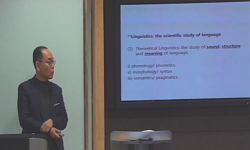This study aimed to identify the meanings and syntactic structures of the Late Middle Korean ‘man’, which is the antecedent form of the Modern Korean particle ‘man’ and the bound noun ‘man’. The research materials used were “Gugeupbang...
http://chineseinput.net/에서 pinyin(병음)방식으로 중국어를 변환할 수 있습니다.
변환된 중국어를 복사하여 사용하시면 됩니다.
- 中文 을 입력하시려면 zhongwen을 입력하시고 space를누르시면됩니다.
- 北京 을 입력하시려면 beijing을 입력하시고 space를 누르시면 됩니다.

후기 중세국어 ‘만’ 구문 -구급방 언해 자료에서 보이는 통사 구성을 중심으로- = On Late Middle Korean ‘man’ constructions - A focus on syntactic structures found in “Gugeupbang” and “Gugeupganibang” -
한글로보기https://www.riss.kr/link?id=A109355624
- 저자
- 발행기관
- 학술지명
- 권호사항
-
발행연도
2024
-
작성언어
Korean
-
주제어
particle ‘man’ ; bound noun ‘man’ ; degree ; limitation ; construction ; syntactic structure ; 조사 ‘만’ ; 의존명사 ‘만’ ; 정도 ; 한정 ; 구문 ; 통사 구성
-
등재정보
KCI등재
-
자료형태
학술저널
-
수록면
1-41(41쪽)
- DOI식별코드
- 제공처
-
0
상세조회 -
0
다운로드
부가정보
다국어 초록 (Multilingual Abstract)
This study aimed to identify the meanings and syntactic structures of the Late Middle Korean ‘man’, which is the antecedent form of the Modern Korean particle ‘man’ and the bound noun ‘man’. The research materials used were “Gugeupbang” and “Gugeupganibang”, which are evaluated to reflect the language of the 15th century. The meanings of Late Middle Korean ‘man’ were broadly divided into {degree} and {limitation}, following previous research, and sub-classifications were attempted for each. In particular, ‘man’ of {degree} was classified into four dimensions: physical dimension, event development dimension, functional dimension, and cognitive dimension. In these meanings, syntactic structures of ‘man’ constructions that are difficult to encounter in Modern Korean could be found. There were not many examples of ‘man’ of {limitation}, and most of them had syntactic structures that could be used in Modern Korean as well. {Maximum}, which can be seen as a special type of range limitation, was established, and constructions with the same meaning as {only} in Modern Korean could be found. Regarding {only}, it was considered worthwhile to explore the possibility that it developed in the context of “do VP to the extent of NP and exclude the rest”, and it was considered possible that {maximum} developed in the context of limiting the event development process.
동일학술지(권/호) 다른 논문
-
- 한성어문학회
- 권성훈
- 2024
- KCI등재
-
- 한성어문학회
- 윤재환
- 2024
- KCI등재
-
교양 한국어 교과목을 위한 수행 평가의 원리 연구 - 교수자・학습자 FGI를 중심으로 -
- 한성어문학회
- 김민경
- 2024
- KCI등재
-
한국어 예비 교원의 글로벌 교육역량 향상을 위한 해외 교육 실습 프로그램의 실제
- 한성어문학회
- 김지윤
- 2024
- KCI등재




 KCI
KCI KISS
KISS






